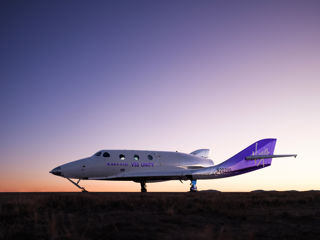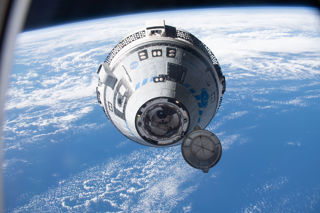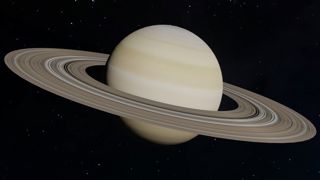
What's Happening in Space: June 2024
- 31st May 2024
- Author: Grace Davis
A summary of space events through the month
Dhara Patel is a Space Expert at the National Space Centre, working to help share space science, stories, and topical news with our visitors and online audiences. Each month she curates a round-up of some notable space and science events coming up the weeks ahead.
There are some great events coming up this June, including a SpaceX Starship test flight, a full moon just after the summer solstice, and the launch of the SVOM French-Chinese mission...

1st June – Boeing CST-100 Starliner spacecraft's Crew Flight Test
Boeing's CFT (Crew Flight Test) with the Starliner spacecraft is scheduled to launch (on a United Launch Alliance Atlas V rocket) no earlier than 5:25pm on 1st June from Cape Canaveral Space Force Station, USA – the first launch of humans from there since Apollo 7 in October 1968. After nearly three weeks of exhaustive tests and data analysis on the small helium leak in the ship’s propulsion system (discovered just before it scheduled launch in early May), NASA managers said that Starliner could safely launch “as is” with no flight safety concern. Boe-CFT will be the first crewed mission of the Boeing Starliner spacecraft (journeying to the International Space Station for a one-week mission) and the third orbital flight test of the Starliner overall after the two uncrewed orbital flight tests, Boe-OFT and Boe-OFT 2 in 2019 and 2022. Starliner is Boeing’s equivalent of SpaceX’s Crew Dragon spacecraft – both companies were selected for NASA’s commercial crew program to take crew to the ISS. Whereas SpaceX has completed testing and been launching crew to the ISS on behalf of NASA since 2020 (with the latest crew launching on 4th March 2024 – Crew 8), Boeing are yet to conduct a successful crewed test. Check out this blog about Boeing Starliner written by Catherine Muller and Mike Darch in our Space Comms Team: https://www.spacecentre.co.uk/news/space-now-blog/boeing-starliner/
3rd June – Moon and Mars close in the sky
Just after midnight on the morning of 3rd June, the waning crescent moon will be in conjunction (sharing the same right ascension – coordinate) with Mars, but the pair will be below the horizon at this time, so not visible from the UK. They will also be at their closest angular separation (close approach) whilst below the horizon so instead try to catch the Moon and Mars in close proximity just before sunrise on this day. They’ll be low on the eastern horizon so you’ll need an extremely clear view without tall buildings or trees that may block your view. Find out more about conjunctions, close approaches and other astronomical phenomena in our blog written by David Southworth in our Education Team: https://www.spacecentre.co.uk/news/space-now-blog/astronomical-phenomena/.
5th June – SpaceX Starship – Test Flight 4
Starship is made up of the Super Heavy booster – a first stage rocket with 33 of SpaceX’s raptor engines, and on top of that sits the upper stage - rather confusingly also called Starship (which hosts 6 engines). And when its fully developed, this launch vehicle will be a completely reusable rocket – both first and second stages.
- Test flight 4 is currently scheduled for 1:00pm on 5th June, from SpaceX’s launch facility, Starbase, in Boca Chica, Texas, United States. The flight could be delayed, as SpaceX are still waiting on regulatory approval from the Federal Aviation Administration (FAA). Both vehicles will have been further adapted for this flight based on any faults detected during Flight Test 3. The focus of this fourth flight test is to achieve orbit and demonstrate the ability to return and reuse the vehicles by executing a landing burn and soft splashdown in the Gulf of Mexico with the Super Heavy booster, and achieving a controlled re-entry of Starship.
Find out more about Starship and SpaceX’s other rocketry achievements in this blog by Ed Turner in our Education team: https://www.spacecentre.co.uk/news/space-now-blog/spacex-the-world-s-rocket-giant/
6th June – new moon (1:37pm)
The new moon on 6th will occur in the constellation of Taurus. We have a blog on ‘phases of the moon’ written by Mike Darch in our Space Comms team: https://spacecentre.co.uk/blog-post/moon-phases/

8th June – Virgin Galactic's Galactic-07 mission
VSS Unity (the crewed spacecraft) will aim for suborbital flight through the help of a double-bodied carrier aircraft called VMS Eve, which will take off from a runway at Spaceport America. Once at an altitude of around 15km, VSS Unity will release from VMS Eve, after which it will fire its rocket engine and travel the rest of the way to space on its own reaching an altitude of roughly 85km – higher than the Karman line / boundary of space as defined by NASA. The suborbital flight will last long enough to grant the Galactic 07 crew members a few minutes of weightlessness. Post-flight reviews of the last mission showed that an alignment pin detached from the launch pylon of our mothership, VMS Eve, during flight. The Federal Aviation Administration (FAA) have now accepted Virgin Galactic's final investigation report, as well as the corrective actions allowing this next flight t take place. The crew have yet to be announced but the flight will carry four customers – a mix of researchers (from Axiom Space) and private astronauts (from the USA and Italy). Galactic 07 may also be the final flight of VSS Unity. The company plans to halt flights of the spaceplane in the middle of the year to focus its resources on development of the Delta class of suborbital vehicles. The new spacecraft will be larger and able to carry six passengers on board rather than Unity’s four-person capacity, and will require less maintenance between flights rendering it capable of launching up to twice a week (compared to Unity’s once a month capability).
20th June – summer solstice (9:49pm)
In the Northern Hemisphere, the June solstice (also called the summer solstice) is when during its yearly orbit, the North Pole of the Earth becomes tilted towards the Sun and reaches its northernmost position in the sky being directly over the Tropic of Cancer. This marks the beginning of northern hemisphere summer in the astronomical calendar. We experience the year's longest day in terms of daylight. Find out more about solstices in this blog by Catherine Muller previously in our Space Comms team: https://spacecentre.co.uk/blog-post/equinoxes-and-solstices/
22nd June – full moon (2:07am)
Known as the Strawberry moon (according to the old Farmers’ Almanac), this full moon is named after the wild strawberries that start to ripen during early summer. Check out the “Full Moon: Full Facts” blog written by Mike Darch in our Space Comms team: https://spacecentre.co.uk/blog-post/full-moon-facts/.
24th June – SVOM mission
SVOM (Space Variable Objects Monitor) is a French-Chinese mission dedicated to the studying variable events like the most distant explosions of stars and gamma-ray bursts in X-ray and optical light. The mission is scheduled to launch on 24th June (time tbc) from the Xichang Satellite Launch Center in China on a Long March 2C rocket. The University of Leicester has provided a bespoke mirror for one of its instruments - the Microchannel X-ray Telescope (MXT). X-ray telescopes are used to study the most energetic forms of matter in the universe, but they have to be launched into orbit to avoid the obscuring effects of the Earth’s atmosphere. Traditionally, X-ray mirrors are quite heavy and expensive for space but the ‘lobster lens’ (based on the eyes of lobsters) design of the University’s optics, allows the telescope to be lighter and provide wider views of the sky.

27th June – Moon and Saturn close in the sky
On the afternoon of 27th June, the waning gibbous moon will be in conjunction (sharing the same right ascension – coordinate) with Saturn, but they’ll be below the horizon at this time, so not visible from the UK. They will also be at their closest angular separation (close approach) whilst below the horizon so instead try to catch the Moon and Saturn in close proximity just before sunrise on 27th June (where the Moon will be to the west/right of Saturn) or in the predawn hours of 28th June (where the Moon will have moved to the east/left of Saturn) . They’ll be relatively high on the eastern horizon but having a clear view without tall buildings or trees that may block your view is still helpful. Check out the astronomical phenomena blog linked above to find out more about conjunctions and close approaches.
30th June – Spot Comet 13P/Olbers
Comet 13P/Olbers is making its 69-year visit to the inner solar system and will reach perihelion (closest approach to the Sun) on 30th June. It will be too faint to see with the naked eye but potentially visible using a small pair of binoculars (with an aperture of 50mm). Throughout June it will brighten and travel from the constellation of Auriga into Lynx which will be low in the northwest around sunset, so you’ll need a very good view of the horizon to stand a chance of spotting it. By the end of the month is will reach perihelion – try looking out for it around this date appearing beside the star Alsciaukat (31 Lyncis) in the constellation of Lynx. The comet should be visible as a pale fuzzy patch in good binoculars (looking like a small nebula with a bright centre) and its tail may be discernible.
Please note: As this summary is created at the end of the month before, dates (especially launch dates) can often change or be updated, so this content may become outdated - we always recommend checking on the relevant organisation's pages.
